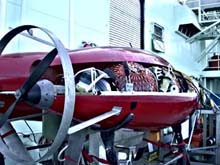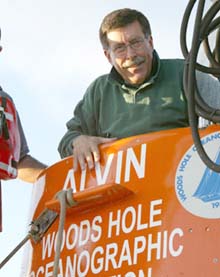
ABE emerges as a likely hero in this mission, able to survey remotely and autonomously. By launching ABE at night after Alvin's return, it surveys a pre-determined pathway along the ocean bottom, and can surface at first light to report its data, suggesting new areas to explore. Here, ABE is opened for maintenance, revealing the complex interior of what may appear to be a simple machine. Click image for larger view.
The Team Explores the Rose Garden
May 26, 2002
Today is the first day of diving on the expedition for Alvin, but the day begins much sooner that the 0800 dive time for the sub. During the night, all work occurred according to plan. ABE ran its intended survey, completely alone as an autonomous vehicle, and was recovered on target at 0600 this morning. Almost immediately, data was downloaded from ABE's computers, and worked into a small chartlet of the survey area. We hope to find the Rose Garden area. The CTD cast lasted through the early morning hours of the night. It provided water samples for analysis of temperature, and the DNA of organisms contained in the water.
On today's dive, Expedition Coordinator Pat Hickey will pilot Alvin, and Co-Chief Scientists Drs. Steve Hammond of NOAA, and Tim Shank of WHOI will make the dive. After a lengthy search, the crew found the beginnings of a recently created lava field. Earlier visits to the Rose Garden were based on less precise navigation tactics, and the transposition of those earlier positions to our modern GPS accuracy, will likely cause offset. Near the end of the dive, the team was successful and did locate a biologically inhabited young vent. Perhaps tomorrow we will confirm that it is part of the Rose Garden, or another adjacent location. Either way, our team is seeing something new. We are exploring.

Expedition Co-Chief Scientist, Dr. Steve Hammond, emerges from the Alvin after a 9.5 hour dive to the seabed in approximately 2500 meters of water. Though the experience is tiring, Dr. Hammond's enthusiasm for the dive was very high.
May 26, 2002
Alvin Dive No. 3788
Map and sample the Rose Garden hydrothermal vent site
Pilot: Pat Hickey, Alvin Expedition Leader
Science Observers: Tim Shank and Stephen Hammond, Co-Chief Scientists
By Dr. Steve Hammond,
Chief Scientist, NOAA Office of Ocean Exploration
Background
Rose Garden is one of several Galapagos Ridge sites where, 25 years ago, a team of oceanographers discovered sea floor hot springs and a whole new, previously unsuspected new biology that is not dependent on the sun or photosynthesis. These dives, which occurred in the late 1970s, are arguably the most important dives ever accomplished by the Alvin submersible. Discovery of the hot springs and their associated animal communities led to major new national and international physical, chemical, and biological oceanographic investigations, which continue today. The objective of this cruise, and this first dive in particular, was to observe the present-day characteristics of the famous Rose Garden vent site. This site is important because a growing body of evidence indicates that sea floor vents do have significant impacts on the physical, chemical, and biological environments and processes throughout the global ocean. Micro-organisms that have been discovered living beneath the oceanic crust in volcanically active regions like the Galapagos Ridge present many opportunities for scientific research. For example, learning about the origins of life on Earth and acquiring genetic and enzymatic materials likely will enable the creation of new biotechnologies and pharmaceuticals.
Objectives
The primary objective for this Alvin dive is to relocate the Rose Garden vent. Maps made in the late 1970s were not as precise as those we are now capable of generating, and in order to relocate the site, we anticipated that some reconnaissance surveying would be required. Once the site is located, the site will be remapped. Then, chemical, thermal, and biological sampling may be conducted. These activities would provide scientists with something that our deep sea science community badly needs—new data. Techniques and procedures planned for accomplishing these tasks include: (1) using a new fluid sensor that senses pH, hydrogen sulfide, hydrogen, and temperature; (2) use of fluid samplers, including gas-tight titanium bottles; and (3) conducting a detailed near-bottom magnetic survey.
Results
The dive resulted in the discovery of a relatively small vent, about 50 square meters, characterized by a wide variety of vent-specific animals. Large tubeworms, at least two species of crustaceans, mussels, clams, and sepulids were found. Nearly the entire dive was spent attempting to relocate the Rose Garden site. During the search, we saw a wide variety of lava flow morphologies. Interestingly, most of the flows were essentially devoid of visible animal life. It should be possible to compare these flow types and relationships to geological maps made 20 or more years ago. During the course of the dive, the submarine traveled approximately 6 km.
Sign up for the Ocean Explorer E-mail Update List.















